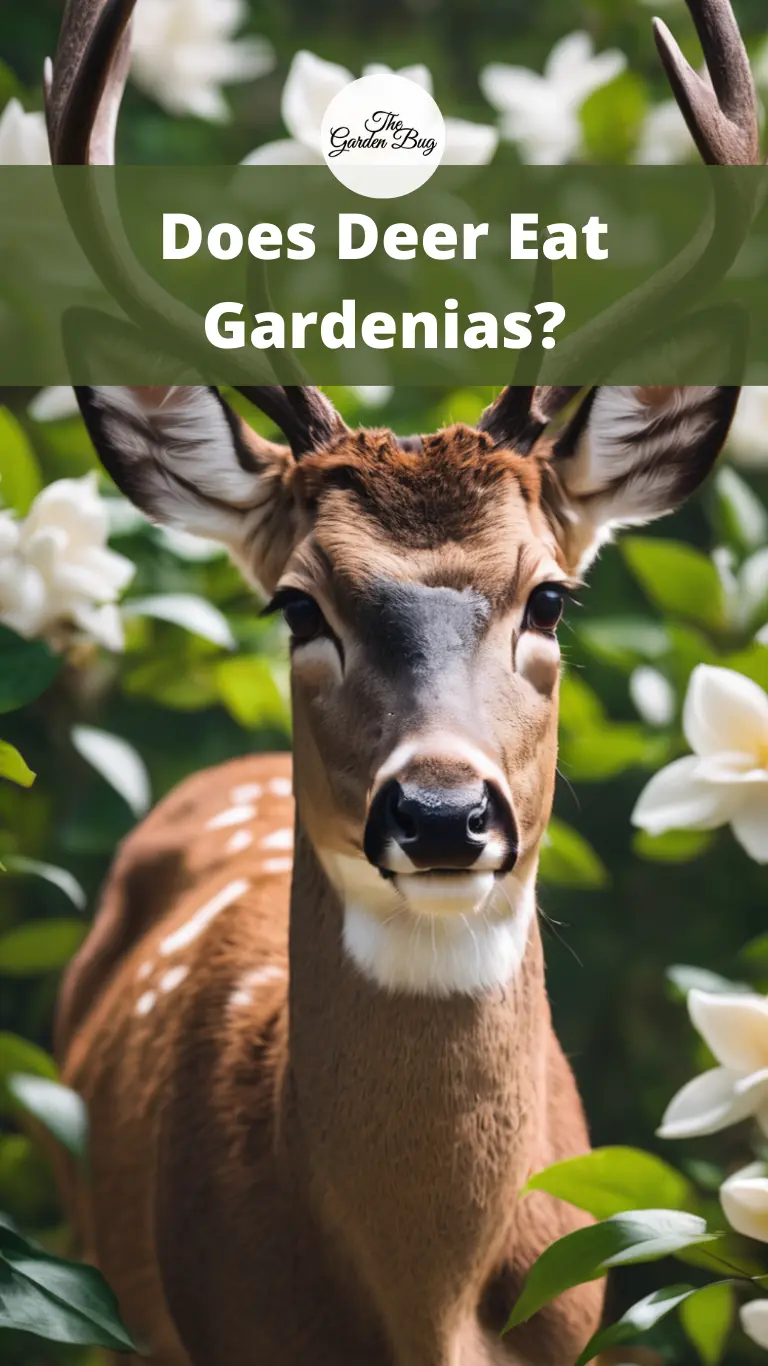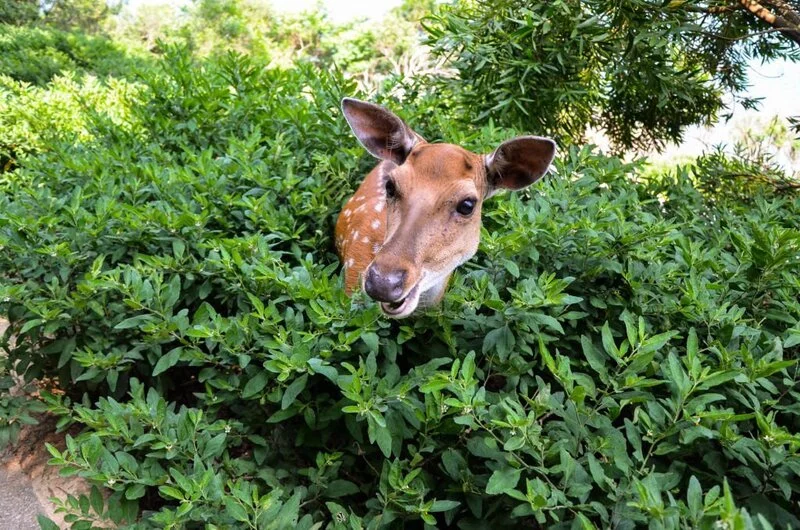If you’re like most gardeners, you love the challenge of growing beautiful flowers. One of those might just be the fragrant gardenia, known for its lush white flowers and glossy green leaves. But as we immerse ourselves in the joy of gardening, we must also be mindful of the natural wildlife, like deer, that can find our plants just as appealing as we do. This article will focus on the question: Do deer eat gardenias? Let’s dive in.
- usda zone 7-10
- “mature size 36″” w x 36-48″” h”
- full sun to partial shade
- evergreen – year round interest
- white fragrant blooms spring through summer
Deer Dietary Habits
The first step to answer our main question is to understand a deer’s diet. Deer are herbivores, which means they eat a variety of plants, shrubs, and trees. Their menu changes with the seasons and what’s readily available. In the spring and summer, they munch on the tender green growth of many plants and shrubs, while in the fall and winter, they’re more likely to eat tree bark and twigs.
It’s also essential to note that deer are creatures of opportunity. If food is scarce due to drought, harsh winter, or overpopulation, deer can venture into our gardens in search of sustenance. They might sample plants that aren’t typically their first choice when hungry enough. Now that we have a general understanding of deer dietary habits, we can focus on their relationship with gardenias.
Deer and Gardenias: A Close Examination
We’ve learned that deer are not picky eaters, but does this flexibility extend to gardenias? Well, the good news for gardenia enthusiasts is that these plants are not at the top of the deer’s dining list. Gardenias are known to be “deer-resistant” rather than “deer-proof,” which means that while they are less likely to be eaten, a really hungry deer might still give them a try.
Why are gardenias less appealing to deer? One reason is that gardenias have a strong scent, and deer tend to shy away from strongly scented plants. Additionally, the leaves of the gardenia are rather tough and leathery, making them less appetizing to deer who prefer tender, succulent greens.
Factors that Influence Deer to Eat Gardenias
While gardenias aren’t a deer’s favorite snack, several factors could drive these creatures to munch on them. The main factor is food scarcity. If the deer’s regular food sources are depleted, they might resort to less preferred plants, including gardenias.
A deer’s taste can also vary depending on the region and what other food sources are available. A deer that has never encountered a gardenia might try it out of curiosity, while those in another area might ignore it altogether.
Other factors include the size of the local deer population and the season. If there are too many deer and not enough food to go around, your gardenias may be at risk. During harsh winters when food is scarce, deer might also be more inclined to sample your gardenias.
Techniques to Protect Gardenias from Deer
So, you’ve noticed some nibbled gardenias in your garden, or you just want to prevent such an incident. How can you protect your precious plants? Here are a few simple techniques:
- Use Deer Repellents: Various commercial repellents can deter deer from your garden. These products work by either giving off a scent that deer don’t like or making the plants taste bad. You can spray these repellents around your garden and directly onto your gardenias.
- Install Fencing: A physical barrier can keep deer out of your garden. Deer are amazing jumpers, so make sure the fence is at least 8 feet high.
- Plant Deterrents: Planting strong-smelling plants around your gardenias can deter deer. These can include plants like lavender, mint, or rosemary.
- Use Noise and Light: Deer are skittish creatures. Using devices that emit noise or light when they sense movement can scare deer away.
- Proven to Repel Deer – The repellent station contains 100% dried blood, a scent that triggers a flight response in deer, causing them to flee the area
- Odorless to Humans – Though the scent is easily detected by the heightened senses of deer, the repellent scent is not detectable to humans
- Weatherproof Housing – The rugged housing is specially designed to keep water out of the station while allowing air to travel through and spread the scent
- Safe for Vegetable Gardens – The repellent is contained safely inside the housing, allowing for placement anywhere outdoors. Hang them from branches or stake them in gardens
- Season-Long Protection – Apply the repellent stations once for season-long protection against deer. One 6 pack covers up to 192 sq ft
Alternatives to Gardenias: Deer-Resistant Plants
If you find that deer are too persistent a problem, you might consider planting more deer-resistant plants. Although no plant is entirely deer-proof, some plants are less likely to be eaten.
Here are a few options:
- Lavender: This plant not only has beautiful purple flowers but also a strong scent that deer tend to avoid.
- Rosemary: This is a great option if you also like cooking with fresh herbs. Deer don’t typically like the strong scent of rosemary.
- Boxwood: This is a popular choice for hedges and borders, and deer don’t usually eat it.
- Marigold: These vibrant flowers can add color to your garden, and they have a strong scent that can deter deer.
- STARTER HERBS: This four pack of Lavender is a great start to your own lavender field or in addition to your current garden.
- GROWTH: Lavender can get up to 3 ft tall and 4 ft wide, their silver green leaves and purple flowers are striking during the summer.
- CARE: Lavender plants thrive in full sunlight with well-draining soil that is on the drier side. Lavender is a resilient plant that is extremely drought-tolerant once established.
- FUN FACT: Lavender has been shown to affect the parasympathetic nervous system, which controls bodily processes such as heart rate, breathing rhythm, and hormone secretion; it even aids in sleep!
- LIVE PLANTS: Our plants are grown exclusively for Deep Roots and The Three Company, shipped fresh directly from our greenhouse to you!
Remember, local deer populations can have different tastes, so it’s always a good idea to observe and adapt your garden as necessary.
Frequently Asked Questions About Deer and Gardenias
Do deer like all types of gardenias?
Generally, deer are not particular about the type of gardenia they consume. However, the attractiveness can vary based on the availability of other food sources.
What time of year are gardenias most at risk from deer?
Deer can pose a threat to gardenias throughout the year, but they are particularly problematic during winter and early spring, when food sources are limited.
Are there any other animals that eat gardenias?
Aside from deer, gardenias can also be appealing to certain pests like aphids, whiteflies, and mealybugs.
Conclusion
In conclusion, while gardenias are a beautiful addition to any garden, they might also become an attractive meal for a hungry deer. While there’s no 100% foolproof method to prevent deer from eating gardenias, employing a combination of deterrents can greatly reduce the likelihood. Remember to monitor your garden regularly, apply deer repellents as needed, and consider integrating more deer-resistant plants into your landscape. Ultimately, successful gardening involves a bit of trial and error, so don’t be discouraged if your first few efforts don’t yield perfect results. With persistence, you’ll soon have a garden that’s both beautiful to look at and less likely to attract unwanted guests!







